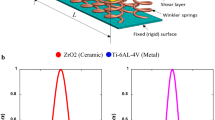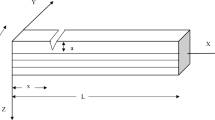Abstract
A hybrid analytical-intelligent approach is proposed for fuzzy reliability analysis of the composite beams reinforced by zinc oxide (ZnO) nanoparticle. The fuzzy reliability index corresponding to buckling failure mode of nanocomposite beam under thickness-direction external voltage is computed based on three-levels: (1) fuzzy analysis, (2) reliability analysis and (3) analytical buckling analysis. In fuzzy analysis level, an improved gravitational search algorithm has been applied to determine uncertainty interval for membership levels of reliability index. The adaptive formulation with a dynamical self-adjusting process is used for reliability analysis level based on conjugate first-order reliability method (FORM). The self-adjusting term in conjugate sensitivity vector is used to satisfy the sufficient descent condition for controlling instability of FORM formula while the proposed conjugate scalar factor is computed less than the original conjugate FORM, thus it may be provided with the efficient results for the convex problem. The new and previous sensitivity vectors obtained by conjugate and steepest descent vectors dynamically adjusted the proposed conjugate factor. In the buckling analysis level, an exponential theory in conjunction with the method of energy is utilized. Fuzzy random variables including applied voltage, the volume fraction of ZnO, thickness of beam, spring constant and shear constant of the foundation are considered in studied nanocomposite beam. Survey results indicated that the proposed method can provide stable and acceptable fuzzy membership functions for parametric study. Moreover, the ratio of length to thickness and spring constant of foundation are the more sensitive parameters which affect fuzzy reliability index significantly.















Similar content being viewed by others
References
Zhu S-P, Huang H-Z, Peng W, Wang H-K, Mahadevan S (2016) Probabilistic physics of failure-based framework for fatigue life prediction of aircraft gas turbine discs under uncertainty. Reliab Eng Syst Saf 146:1–12
Benferhat S, Kreinovich V, Levray A, Tabia K (2018) Qualitative conditioning in an interval-based possibilistic setting. Fuzzy Sets Syst 343:35–49
Dinh-Cong D, Van Hoa N, Nguyen-Thoi T (2019) An effective optimization-based parameterized interval analysis approach for static structural response with multiple uncertain parameters. Eng Comput. https://doi.org/10.1007/s00366-019-00803-3
Wang C, Matthies HG (2019) Novel model calibration method via non-probabilistic interval characterization and Bayesian theory. Reliab Eng Syst Saf 183:84–92
Xiao M, Zhang J, Gao L, Lee S, Eshghi AT (2019) An efficient Kriging-based subset simulation method for hybrid reliability analysis under random and interval variables with small failure probability. Struct Multidiscip Optim 59(6):2077–2092. https://doi.org/10.1007/s00158-018-2176-z
Zhang J, Xiao M, Gao L, Chu S (2019) A combined projection-outline-based active learning Kriging and adaptive importance sampling method for hybrid reliability analysis with small failure probabilities. Comput Methods Appl Mech Eng 344:13–33. https://doi.org/10.1016/j.cma.2018.10.003
Xie C, Li G, Wei F (2018) An integrated QMU approach to structural reliability assessment based on evidence theory and kriging model with adaptive sampling. Reliab Eng Syst Saf 171:112–122
Zhang X, Gong Y, Spece M (2019) Trust decision model for online consumer evaluation: deeper uncertainty integration in evidence theory approach. J Intell Fuzzy Syst 36(5):4257–4264
Zhang J, Xiao M, Gao L, Qiu H, Yang Z (2018) An improved two-stage framework of evidence-based design optimization. Struct Multidiscip Optim 58(4):1673–1693. https://doi.org/10.1007/s00158-018-1991-6
Doan LTT, Amer Y, Lee S-H, Phuc PNK, Dat LQ (2019) A comprehensive reverse supply chain model using an interactive fuzzy approach-a case study on the Vietnamese electronics industry. Appl Math Model 76:87–108
Hryniewicz O (2016) Bayes statistical decisions with random fuzzy data—an application in reliability. Reliab Eng Syst Saf 151:20–33
Jović S (2019) Prediction of aerodynamics performance of continuously variable-speed wind turbine by adaptive neuro-fuzzy methodology. Eng Comput. https://doi.org/10.1007/s00366-019-00716-1
Wang L, Xiong C, Wang X, Liu G, Shi Q (2019) Sequential optimization and fuzzy reliability analysis for multidisciplinary systems. Struct Multidiscip Optim 60(3):1079–1095
Ji J, Zhang C, Gao Y, Kodikara J (2019) Reliability-based design for geotechnical engineering: an inverse FORM approach for practice. Comput Geotech 111:22–29
Meng D, Huang H-Z, Wang Z, Xiao N-C, Zhang X-L (2014) Mean-value first-order saddlepoint approximation based collaborative optimization for multidisciplinary problems under aleatory uncertainty. J Mech Sci Technol 28(10):3925–3935
Meng Z, Keshtegar B (2019) Adaptive conjugate single-loop method for efficient reliability-based design and topology optimization. Comput Methods Appl Mech Eng 344:95–119. https://doi.org/10.1016/j.cma.2018.10.009
Huang X, Li Y, Zhang Y, Zhang X (2018) A new direct second-order reliability analysis method. Appl Math Model 55:68–80. https://doi.org/10.1016/j.apm.2017.10.026
Lee C-H, Kim Y (2019) Probabilistic flaw assessment of a surface crack in a mooring chain using the first-and second-order reliability method. Mar Struct 63:1–15
Du W, Luo Y, Wang Y (2019) Time-variant reliability analysis using the parallel subset simulation. Reliab Eng Syst Saf 182:250–257
Meng D, Li Y-F, Huang H-Z, Wang Z, Liu Y (2015) Reliability-based multidisciplinary design optimization using subset simulation analysis and its application in the hydraulic transmission mechanism design. J Mech Des 137(5):051402
Zhang J, Xiao M, Gao L, Fu J (2018) A novel projection outline based active learning method and its combination with Kriging metamodel for hybrid reliability analysis with random and interval variables. Comput Methods Appl Mech Eng 341:32–52. https://doi.org/10.1016/j.cma.2018.06.032
Keshtegar B, Kisi O (2018) RM5Tree: radial basis M5 model tree for accurate structural reliability analysis. Reliab Eng Syst Saf 180:49–61. https://doi.org/10.1016/j.ress.2018.06.027
Gao X, Liu F, Pan L, Deng Y, Tsai SB (2019) Uncertainty measure based on Tsallis entropy in evidence theory. Int J Intell Syst 34(11):3105–3120
Zhu S, Liu Q, Zhou J, Yu Z (2018) Fatigue reliability assessment of turbine discs under multi-source uncertainties. Fatigue Fract Eng Mater Struct 41(6):1291–1305
Zhu W, Xiao F (2019) Improvement of time series data fusion based on evidence theory and DEMATEL. IEEE Access 7:81397–81406
Huang C-L, Huang S-Y, Yeh W-C, Wang J (2019) Fuzzy system and time window applied to traffic service network problems under a multi-demand random network. Electronics 8(5):539
Bagheri M, Miri M, Shabakhty N (2015) Modeling of epistemic uncertainty in reliability analysis of structures using a robust genetic algorithm. Iran J Fuzzy Syst 12(2):23–40
Bagheri M, Miri M, Shabakhty N (2016) Fuzzy reliability analysis using a new alpha level set optimization approach based on particle swarm optimization. J Intell Fuzzy Syst 30(1):235–244
Bagheri M, Miri M, Shabakhty N (2017) Fuzzy time dependent structural reliability analysis using alpha level set optimization method based on genetic algorithm. J Intell Fuzzy Syst 32(6):4173–4182
Keshtegar B, Bagheri M (2018) Fuzzy relaxed-finite step size method to enhance the instability of the fuzzy first-order reliability method using conjugate discrete map. Nonlinear Dyn 91(3):1443–1459
Lu C, Feng Y-W, Fei C-W (2019) Weighted regression-based extremum response surface method for structural dynamic fuzzy reliability analysis. Energies 12(9):1588
Gao H, Zhang X (2019) A novel reliability analysis method for fuzzy multi-state systems considering correlation. IEEE Access 7:153194–153204
Keshtegar B (2016) Chaotic conjugate stability transformation method for structural reliability analysis. Comput Methods Appl Mech Eng 310:866–885
Keshtegar B, Chakraborty S (2018) A hybrid self-adaptive conjugate first order reliability method for robust structural reliability analysis. Appl Math Model 53:319–332. https://doi.org/10.1016/j.apm.2017.09.017
Gong J-X, Yi P (2011) A robust iterative algorithm for structural reliability analysis. Struct Multidiscip Optim 43(4):519–527
Keshtegar B, Hao P (2017) A hybrid self-adjusted mean value method for reliability-based design optimization using sufficient descent condition. Appl Math Model 41:257–270
Keshtegar B, Hao P (2018) Enriched self-adjusted performance measure approach for reliability-based design optimization of complex engineering problems. Appl Math Model 57:37–51
Keshtegar B, Ben Seghier MEA, Zhu S-P, Abbassi R, Trung N-T (2019) Reliability analysis of corroded pipelines: novel adaptive conjugate first order reliability method. J Loss Prev Process Ind 62:103986. https://doi.org/10.1016/j.jlp.2019.103986
Keshtegar B, Zhu S-P (2019) Three-term conjugate approach for structural reliability analysis. Appl Math Model 76:428–442
Keshtegar B (2018) Enriched FR conjugate search directions for robust and efficient structural reliability analysis. Eng Comput 34(1):117–128
Keshtegar B, Chakraborty S (2018) An efficient-robust structural reliability method by adaptive finite-step length based on Armijo line search. Reliab Eng Syst Saf 172:195–206
Keshtegar B (2016) Stability iterative method for structural reliability analysis using a chaotic conjugate map. Nonlinear Dyn 84(4):2161–2174
Keshtegar B (2017) Limited conjugate gradient method for structural reliability analysis. Eng Comput 33(3):621–629
Zamanian M, Kolahchi R, Bidgoli MR (2017) Agglomeration effects on the buckling behaviour of embedded concrete columns reinforced with SiO2 nano-particles. Wind Struct 24(1):43–57
Hajmohammad MH, Zarei MS, Kolahchi R, Karami H (2019) Visco-piezoelasticity-zigzag theories for blast response of porous beams covered by graphene platelet-reinforced piezoelectric layers. J Sandw Struct Mater 1099636219839175
Dabbagh A, Rastgoo A, Ebrahimi F (2019) Finite element vibration analysis of multi-scale hybrid nanocomposite beams via a refined beam theory. Thin Walled Struct 140:304–317. https://doi.org/10.1016/j.tws.2019.03.031
Chen D, Yang J, Kitipornchai S (2017) Nonlinear vibration and postbuckling of functionally graded graphene reinforced porous nanocomposite beams. Compos Sci Technol 142:235–245. https://doi.org/10.1016/j.compscitech.2017.02.008
Polit O, Anant C, Anirudh B, Ganapathi M (2019) Functionally graded graphene reinforced porous nanocomposite curved beams: bending and elastic stability using a higher-order model with thickness stretch effect. Compos B Eng 166:310–327
AkhavanAlavi S, Mohammadimehr M, Edjtahed S (2019) Active control of micro Reddy beam integrated with functionally graded nanocomposite sensor and actuator based on linear quadratic regulator method. Eur J Mech A Solids 74:449–461
Zadeh LA (1996) Quantitative fuzzy semantics. In: Zadeh LA (ed) Fuzzy sets: fuzzy logic, and fuzzy systems. World Scientific, Singapore, pp 105–122
Rashedi E, Nezamabadi-Pour H, Saryazdi S (2009) GSA: a gravitational search algorithm. Inf Sci 179(13):2232–2248
Lipu MH, Hannan M, Hussain A, Saad M, Ayob A, Uddin M (2019) Extreme learning machine model for state of charge estimation of lithium-ion battery using gravitational search algorithm. IEEE Trans Ind Appl 55:4225–4234
Meng Z, Li G, Yang D, Zhan L (2017) A new directional stability transformation method of chaos control for first order reliability analysis. Struct Multidiscip Optim 55(2):601–612
Seghier MEAB, Keshtegar B, Elahmoune B (2018) Reliability analysis of low, mid and high-grade strength corroded pipes based on plastic flow theory using adaptive nonlinear conjugate map. Eng Fail Anal 90:245–261
Yang D (2010) Chaos control for numerical instability of first order reliability method. Commun Nonlinear Sci Numer Simul 15(10):3131–3141
Xia B, Lü H, Yu D, Jiang C (2015) Reliability-based design optimization of structural systems under hybrid probabilistic and interval model. Comput Struct 160:126–134
Hajmohammad MH, Zarei MS, Nouri A, Kolahchi R (2017) Dynamic buckling of sensor/functionally graded-carbon nanotube-reinforced laminated plates/actuator based on sinusoidal-visco-piezoelasticity theories. J Sandw Struct Mater. https://doi.org/10.1177/1099636217720373
Kolahchi R (2017) A comparative study on the bending, vibration and buckling of viscoelastic sandwich nano-plates based on different nonlocal theories using DC, HDQ and DQ methods. Aerosp Sci Technol 66:235–248. https://doi.org/10.1016/j.ast.2017.03.016
Möller B, Beer M (2004) Fuzzy randomness: uncertainty in civil engineering and computational mechanics. Springer, Berlin
Author information
Authors and Affiliations
Corresponding authors
Additional information
Publisher's Note
Springer Nature remains neutral with regard to jurisdictional claims in published maps and institutional affiliations.
Rights and permissions
About this article
Cite this article
Keshtegar, B., Bagheri, M., Meng, D. et al. Fuzzy reliability analysis of nanocomposite ZnO beams using hybrid analytical-intelligent method. Engineering with Computers 37, 2575–2590 (2021). https://doi.org/10.1007/s00366-020-00965-5
Received:
Accepted:
Published:
Issue Date:
DOI: https://doi.org/10.1007/s00366-020-00965-5




